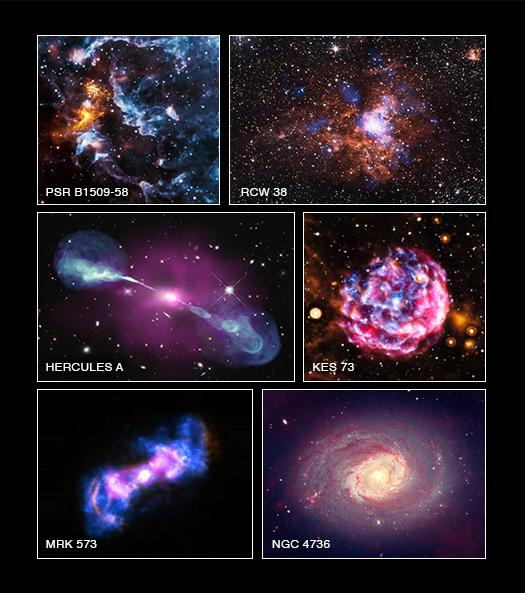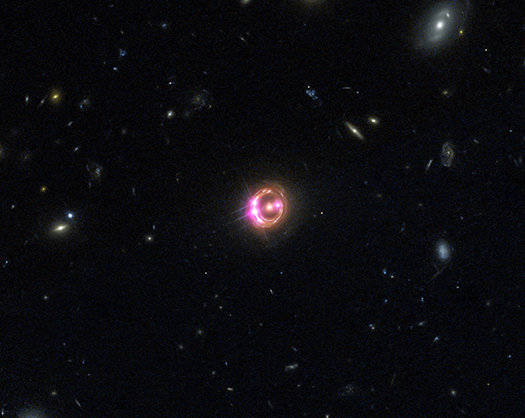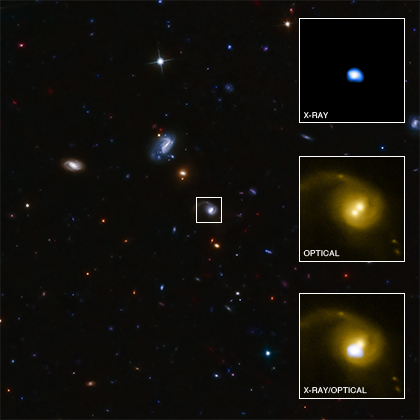Quasars & Active Galaxies
Chandra's Archives Come to Life
Every year, NASA's Chandra X-ray Observatory looks at hundreds of objects throughout space to help expand our understanding of the Universe. Ultimately, these data are stored in the Chandra Data Archive, an electronic repository that provides access to these unique X-ray findings for anyone who would like to explore them. With the passing of Chandra's 15th anniversary in operation on August 26, 1999, the archive continues to grow as each successive year adds to the enormous and invaluable dataset.
Chandra & XMM-Newton Provide Direct Measurement of Distant Black Hole's Spin
Multiple images of a distant quasar are visible in this combined view from NASA's Chandra X-ray Observatory and the Hubble Space Telescope. The Chandra data, along with data from ESA's XMM-Newton, were used to directly measure the spin of the supermassive black hole powering this quasar. This is the most distant black hole where such a measurement has been made, as reported in our press release.
A New Look at an Old Friend
Astronomers have used NASA's Chandra X-ray Observatory and a suite of other telescopes to reveal one of the most powerful black holes known. The black hole has created enormous structures in the hot gas surrounding it and prevented trillions of stars from forming.
Black Hole Powered Jets Plow Into Galaxy
This composite image of a galaxy illustrates how the intense gravity of a supermassive black hole can be tapped to generate immense power. The image contains X-ray data from NASA's Chandra X-ray Observatory (blue), optical light obtained with the Hubble Space Telescope (gold) and radio waves from the NSF's Very Large Array (pink).
How to stumble into a PhD project, and how it can follow you

Teddy Cheung,
Credit: Craig Walker
We are delighted to welcome Teddy Cheung, from the National Academy of Sciences, and resident at the Naval Research Laboratory in Washington DC, to give a guest blog post today. Teddy is first author of a paper describing the discovery of the most distant X-ray jet detected to date. Here, he explains some of the background story behind this discovery.
When I started graduate school in 1999 at Brandeis University, exciting discoveries were being made down the road in Cambridge, Massachusetts, with the then newly launched Chandra X-ray Observatory. The first Chandra image unexpectedly revealed a bright X-ray jet from a distant quasar (https://chandra.harvard.edu/press/99_releases/press_082399.html) and the research groups at SAO and MIT were puzzling over it. But it took me leaving Boston to find my eventual connection.
I spent the summer of 2000 at the Space Telescope Science Institute in Baltimore, Maryland, wanting to learn something entirely new and took on a project in Meg Urry's group studying the galaxies of BL Lac objects (a type of cousin to the quasars) using ground-based near-infrared data. Coincidentally, I shared an office with another graduate student working with Dr. Urry for the summer, Fabrizio Tavecchio from Italy, and they were at that time puzzling over the same Chandra jet detection. Little did I appreciate at the time, that this visit to Baltimore would lead back to my eventual PhD project at Brandeis on the Chandra quasar jets.
Record-Setting X-ray Jet Discovered
This composite image shows the most distant X-ray jet ever observed. X-ray data from NASA's Chandra X-ray Observatory are shown in blue, radio data from the NSF's Very Large Array are shown in purple and optical data from NASA's Hubble Space Telescope are shown in yellow. The jet was produced by a quasar named GB 1428+4217, or GB 1428 for short, and is located 12.4 billion light years from Earth. Labels for the quasar and jet can be seen by mousing over the image. The shape of the jet is very similar in the X-ray and radio data.
Revealing a Mini-Supermassive Black Hole
One of the lowest mass supermassive black holes ever observed in the middle of a galaxy has been identified, thanks to NASA's Chandra X-ray Observatory and several other observatories. The host galaxy is of a type not expected to harbor supermassive black holes, suggesting that this black hole, while related to its supermassive cousins, may have a different origin.
The Science of Black Hole Kicks: An Interview with Avi Loeb

For more context on CID-42 and the science of black hole kicks, we interviewed Professor Abraham (Avi) Loeb, one of the co-authors of the new paper. Avi is the director of the Institute for Theory and Computation, within the Harvard-Smithsonian Center for Astrophysics, and he is currently serving as Chair of the Department of Astronomy at Harvard University. He was recently elected to become a member of the American Academy of Arts & Sciences. Avi has worked on a wide variety of topics in astrophysics, including cosmology, black holes, gravitational lensing by planets and gamma-ray bursts in the distant Universe.
Q: How significant do you think this result is?
A: CID-42 is the best candidate for a massive black hole that might have been kicked out of the center of a galaxy with a high speed. An interesting mechanism for obtaining such a kick involves the merger of two black holes into the kicked black hole.
Close Encounters of the Galactic Kind
Astronomers have used a large survey to test a prediction that close encounters between galaxies can trigger the rapid growth of supermassive black holes. Key to this work was Chandra's unique ability to pinpoint actively growing black holes through the X-rays they generate.
The researchers looked at 562 pairs of galaxies ranging in distances from about 3 billion to 8 billion light years from Earth. They found that the galaxies in the early stages of an encounter with another were more likely than isolated, or "lonelier" galaxies to have actively growing black holes in their cores.
NASA's Chandra Finds Nearest Pair of Supermassive Black Holes
Evidence for a pair of supermassive black holes in a spiral galaxy has been found in data from NASA's Chandra X-ray Observatory. This main image is a composite of X-rays from Chandra (blue) and optical data from the Hubble Space Telescope (gold) of the spiral galaxy NGC 3393. Meanwhile, the inset box shows the central region of NGC 3993 as observed just by Chandra.









